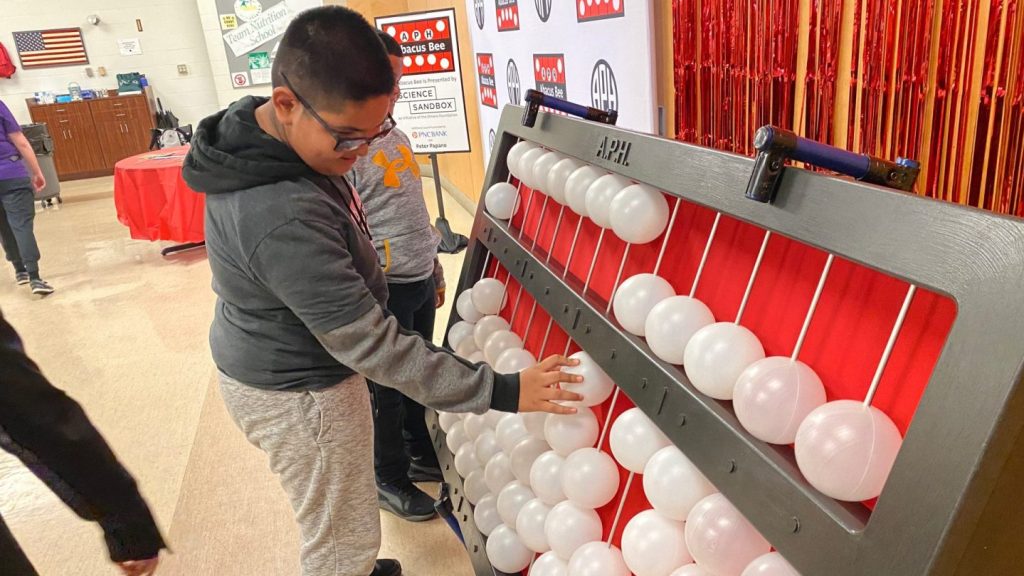APH Customer Service is closed until Monday, December 2nd.
To ensure gift delivery by 12/25, please place orders via UPS shipping no later than 12/17.
CloseAPH Customer Service is closed until Monday, December 2nd.
To ensure gift delivery by 12/25, please place orders via UPS shipping no later than 12/17.
Close
Parents and physical education teachers may hesitate when it comes to allowing their child or student who is blind or low vision to participate in adapted P.E. class. Vision loss can present a challenge when playing sports, but that doesn’t mean it cannot be done with the right attitude and modifications.
Adapted P.E. teacher, Dorothy Niemira, sees parents’ and teachers’ apprehension often. She said, “Every single person, whether you have vision or not, takes a risk when walking out the door. If there’s no risk in your life, then you have a risk deficit, and you’re not going to learn how to overcome those challenges.” Students who are blind or low vision are just as capable as their sighted peers, but if a parent or teacher instills the fearful notion that the student cannot succeed, they will think they cannot. A lack of information about appropriate modifications for sports may also be a barrier to participation.
One way to break down these barriers is to believe in your student or child. They can succeed! Another strategy is to attend Camp Abilities. “In the summer, I work at three Camp Abilities: Brockport Camp Abilities, Saratoga Camp Abilities, and I’m really excited to announce that Jonathan Hooper and I are starting a new camp in New York City,” said Dorothy. This week-long educational sports camp for students who are blind, low vision, and DeafBlind takes place every summer across the U.S. Not only can students participate, but teachers can, too. The counselors are undergraduate and graduate students who are studying physical education or special education. Each coach works one-on-one with an athlete. Dorothy said, “When the future professionals come together and they are paired with that athlete, having that experience changes your perception of teaching.”
The Camp Abilities website also has instructional videos that show how to adapt sports for students. Resources include information about beep baseball and kickball, soccer, cross country, basketball, volleyball, and more.
Dorothy also advises teachers to consider their words carefully when teaching a student a new sport. “If you closed your eyes and you gave instructions, does it make sense? If it doesn’t make sense to you, it’s not going to make sense to your athlete.”
There should never be a concern about whether a student who is blind or low vision should be given the opportunity to play sports. “Quality physical education is adapted to include everyone and gives the students the skills to be active.” In fact, modifying games is simple. For example, Dorothy adapted a version of corn hole where she had her students stand in a line in front of hula hoops. They practiced their underhand toss by throwing a bean bag into the center of the hoop. After it landed, students could move the hula hoop forward with the goal of eventually reaching the cone and winning the game. “One of the students could get eight tosses toward the cones in the same amount of time as another got four. For my two students to compete appropriately, one student’s cones had to be a couple feet back because the other needed a little bit more time. They’re still active, and you’re still having that competition, but it’s at the level that is appropriate for them.”
Adapting a game like this allows them equal opportunities for success. Once students are victorious, they will be excited about physical activities and seek out more. Dorothy added, “We’re learning skills that will translate to us being more independent and healthier for the rest of our lives.”
For more information, check out our other adapted physical education blogs.

This blog was originally published in 2019 as “8 STEM Products for Inclusive Classrooms.” It has been updated to include two...

Have you ever considered how something that many people use every day, like a kitchen appliance, social media platform, or...

Created in China in 1200 C.E., the abacus is an ancient tool used by generations of mathematicians and students before...